High Key vs. Low Key Photography: Comparisons & Examples
Hearing the major debate of “high key vs low key photography,” aspiring photographers are often left wondering which style is best to experiment with. These approaches are, however, based on different lighting techniques for creating different visual effects and moods. This article will delve into key aspects and differences between the two to help you make an informed decision about your photography needs.
Part 1. What Is High Key and Low Key Photography?
Some key points about both lighting techniques of photography are highlighted below:
High Key Photography
1. Using multiple light sources and a high ratio of fill-to-key light, high-key photography focuses on creating a bright effect, minimal shadows, and a positive mood.
2. For maintaining overall brightness and avoiding shadows, a wide aperture, lower ISO, and an adjusted shutter speed are employed among camera settings.
3. High-key photography is used in the advertisement and fashion industry due to its cheerful and bright mood created through the light backgrounds and lights at different angles.
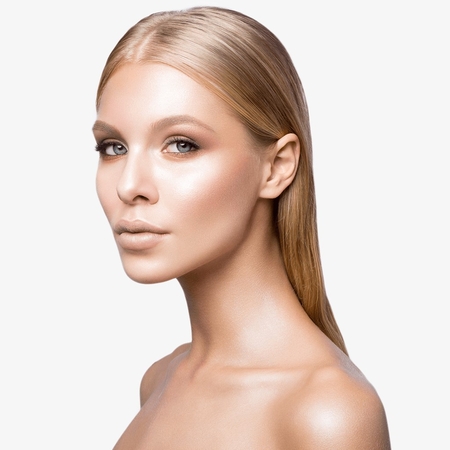
Low Key Photography
1. Hard shadows, strong contrast, and highlights are the focused areas in low-key photos, utilizing a single key light, sometimes with minimal fill light.
2. To get dark tones and a high contrast of low-key photographs, a slightly low ISO, a low f-stop, and a high shutter speed are ideally used.
3. This technique, resulting in dark images with depth and subtle highlights created by setting a dark background, is utilized in stylized portraiture, still life, film, and landscapes.
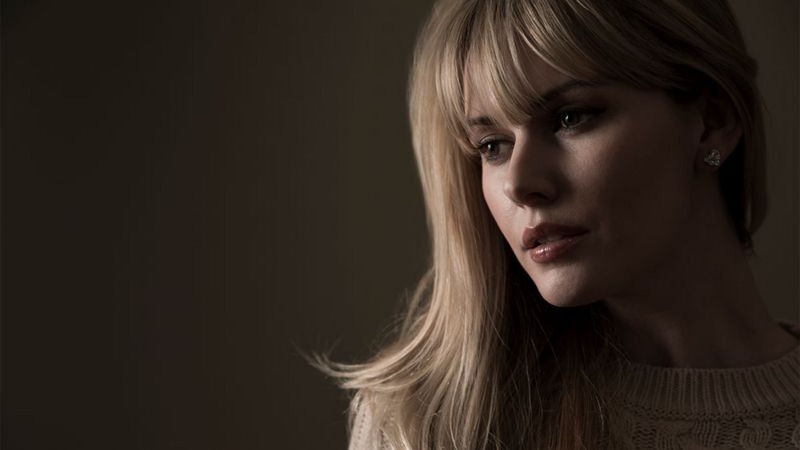
Part 2. Comparing High-Key and Low-Key Lighting in Photography
While studying these two contrasting lighting styles of photography, the major differences must be kept in mind:
| Features | Low-key Photography | High-key Photography |
|---|---|---|
| Lighting | Minimal lighting, often with a single source | Bright, even lighting from multiple sources |
| Shadows | Deep and pronounced shadows | Very soft and minimal shadows |
| Contrast | High | Low |
| Mood/Effect | Dramatic, mysterious, and moody effect | Clean, positive, and bright effect |
| Background | Very dark or black | Very light or bright |
| Common Uses | Portraits, fine arts, and dramatic storytelling | Fashion and beauty industry, product photography |
Part 3. How High-Key and Low-Key Photography Differ in Shooting Techniques
Apart from the above-stated differences, the two techniques also differ in the following shooting techniques:
Lighting Setup
In a high-key style, the key light, the fill light, and the diffuser are used in combination with a light background to create a shadow-canceling effect. In low-key pictures, mainly one key light source is used, sometimes complemented with rim lights and fill light to achieve a dramatic shadow effect.
Camera Settings Adjustment
When doing a low-key shoot, a low ISO, low f-stop, and a faster shutter speed are utilized to achieve the hard shadows. For taking high-key pictures, overexposing the image and using a manual mode to adjust ISO and aperture helps to get a bright effect with minimal shadows.

Backgrounds
Generally, a black or a very dark background is used while taking low-key photos to create depth and avoid unnecessary light reflections. On the other hand, backgrounds used for high-key photography are usually very light in color or plain white to avoid shadows and distractions.
Part 4. Examples of High Key and Low-Key Photography in Practice
Here are a few examples of uses of these two contrasting techniques of photography:
Low-Key Photography Examples
1. Classic portraits where certain features of the face are to be highlighted while the rest of the face stays in shadow are achieved through low-key techniques.
2. To take portraits with Rembrandt lighting, where a triangular shadow appears under the eyes and nose of the subject, is also done with low low-key style.
3. Still-life photos where the form and texture of the product are to be emphasized, contrasting with some dark background; low-light lighting does the job.
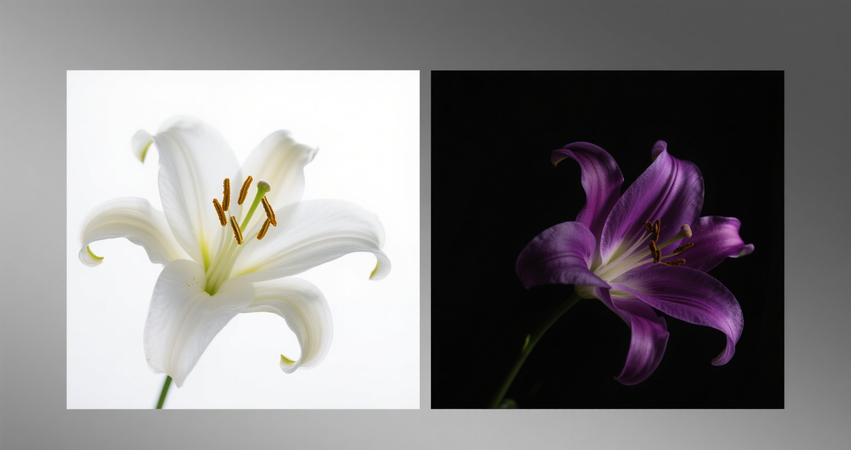
High Key Photography Examples
1. Weddings and family pictures, where a joyful and light mood is required, high-key photography is used.
2. For landscape photos, especially where a mood-lift is needed to brighten foggy atmospheric conditions, the high-key method is the best choice.
3. For product photos for advertisement and marketing purposes where a brightened effect is suitable, a high-key photography technique is needed.

Part 5. Enhancing High Key and Low Key Photos Using HitPaw FotorPea
Having tried high-key, low-key photography, you may have managed to capture a low-key portrait with rich shadows and highlights. The next important thing is to enhance its quality and resolution for printing our clear and highly detailed images without compromising its aesthetics. For this purpose, use HitPaw FotorPea and its various AI Models, like upscale, denoise, and low-light, to achieve stunning images.
Key Features
1. The smart Denoise Model reduces image grain and noise in shadow areas to produce sharp and detailed images.
2. With the AI Upscale Model, boost the resolution of the photo up to 16K with minimal artificing, for crisp results on larger prints.
3. Use the Face Model to remove blemishes and refine the facial textures of high and low-key photos without losing the details.
4. Its Low-light Model brightens the low-light images to provide you with images with balanced lighting effects.
5. If your images are high-key, use the Color Calibration Model to fix the saturation and overly exposed photos.
Guide on Enhancing High Key and Low Key Photos With FotorPea
Now, you can follow this instructional guide and learn how to enhance these high-key and low-key images using the software:
Step 1. Access HitPaw FotorPea and Import ImagesOn the main interface of this software, click the “Enhance Photos Now” button, and import the high and low-key photos to proceed.
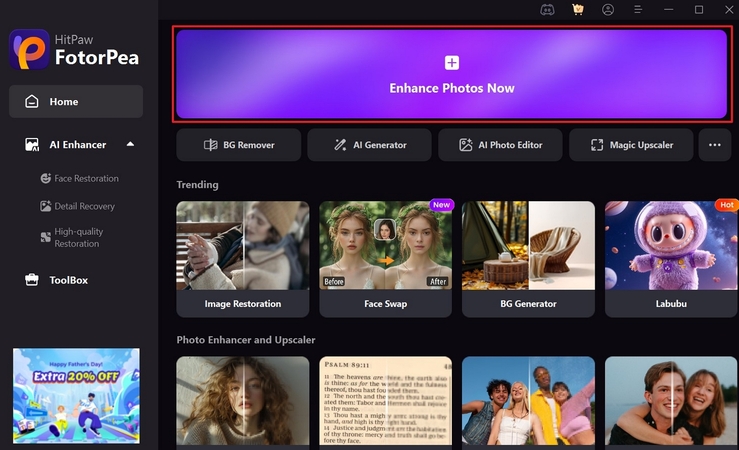
Step 2. Toggle the Enhancer Model
Next, toggle the “Upscale Model” on both images, choose the “Aspect Ratio,” “Mode,” and hit the “Preview” button.
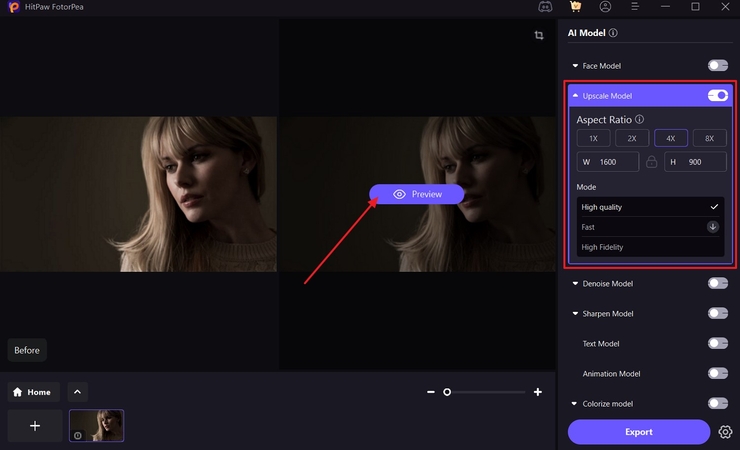
Step 3. Preview the Enhanced Images and Export
Once the images are upscaled, preview them one by one, and press the “Export” button to save them.
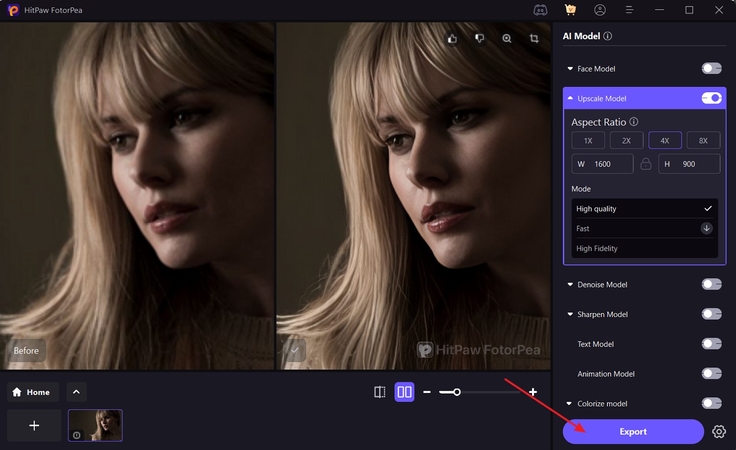
Part 6. FAQs on High Key Low Key Photography
Q1. What are the settings that are ideal for low-key photography?
A1. The setting for low-key photography is to set the ISO to low as 100-200, with a wide aperture of f/1.8, and a fast shutter speed. These settings help control the lighting on the subject without leaving a dark background.
Q2. How does HitPaw FotorPea handle high-contrast images?
A2. FotorPea utilizes AI technology to enhance and handle high-key photos by keeping its shadows and highlights intact. Additionally, the AI Models ensure that color balance and texture are upgraded too high-quality.
Q3. Can high-key photography be done outdoors?
A3. Yes, you can take high-key photos under the overcast skies or in snowy settings by using bright backgrounds and overexposure settings. Furthermore, set the camera to a wide aperture and maintain the exposure to give the pictures a bright look.
Q4. What are some great low-key photography ideas?
A4. If you want to achieve dramatic portraits in low-key settings and environments, try shooting the subject with textured objects, in the wildlife at night, and more. Photographers need to ensure that to keep the lighting to a minimum and go for high contrast and mood.
Conclusion
Summing up, we have explored two major photography techniques in this article, including their key differences and uses. We have compared high and low-key photography styles in their shooting and lighting techniques and their different use cases. Moreover, to enhance high-key and low-key photography, we have introduced a photo-enhancing tool with specialized AI models designed for upgrading photo quality, namely HitPaw FotorPea.










 HitPaw Edimakor
HitPaw Edimakor HitPaw VikPea (Video Enhancer)
HitPaw VikPea (Video Enhancer) HitPaw Univd (Video Converter)
HitPaw Univd (Video Converter) 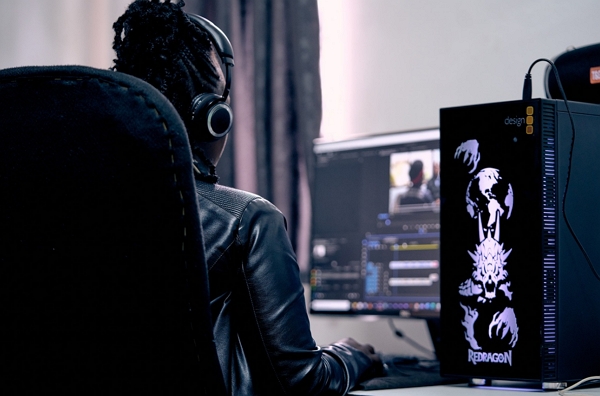
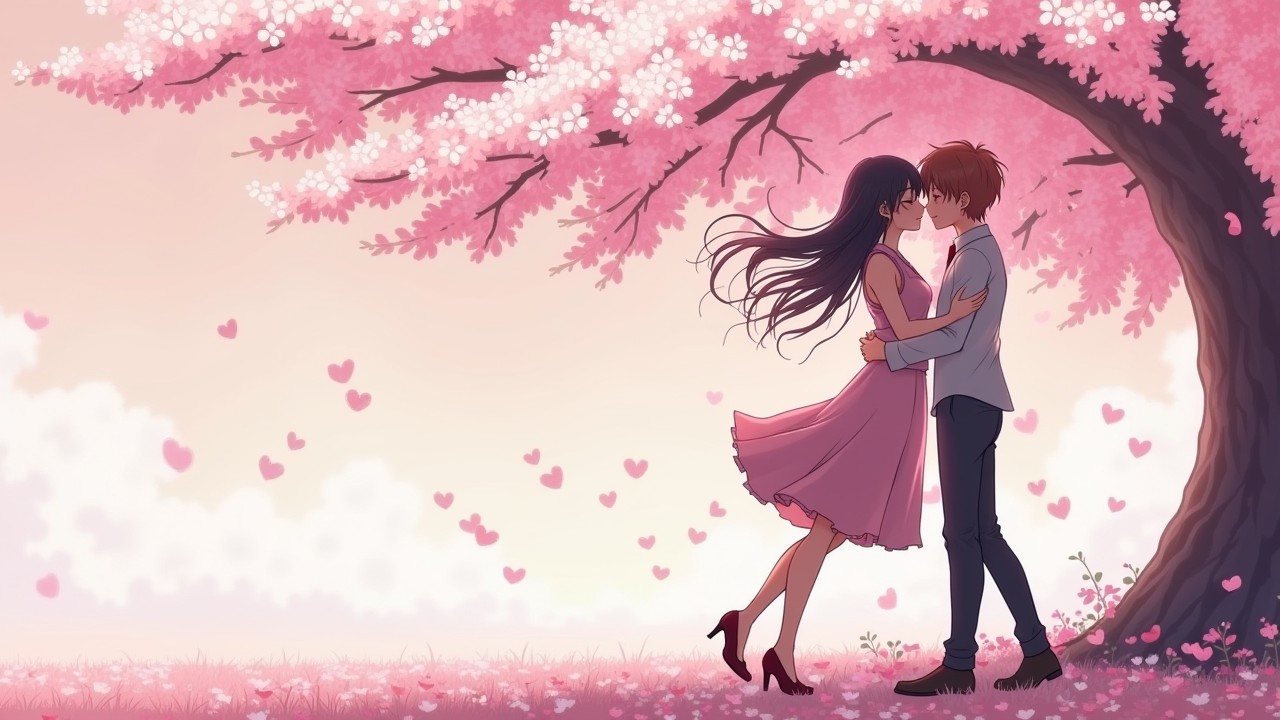
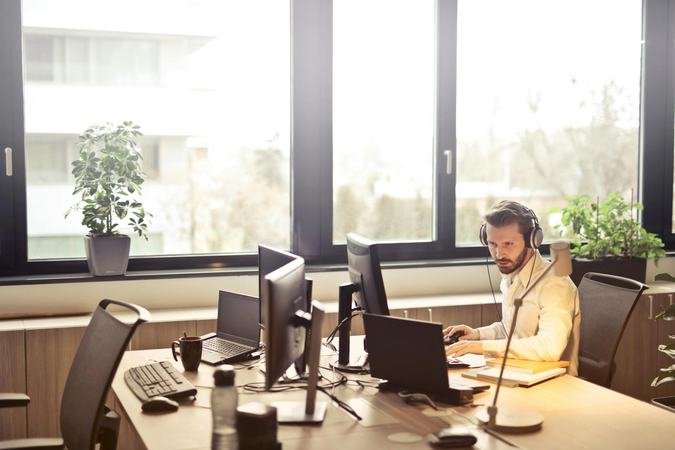

Share this article:
Select the product rating:
Daniel Walker
Editor-in-Chief
This post was written by Editor Daniel Walker whose passion lies in bridging the gap between cutting-edge technology and everyday creativity. The content he created inspires the audience to embrace digital tools confidently.
View all ArticlesLeave a Comment
Create your review for HitPaw articles